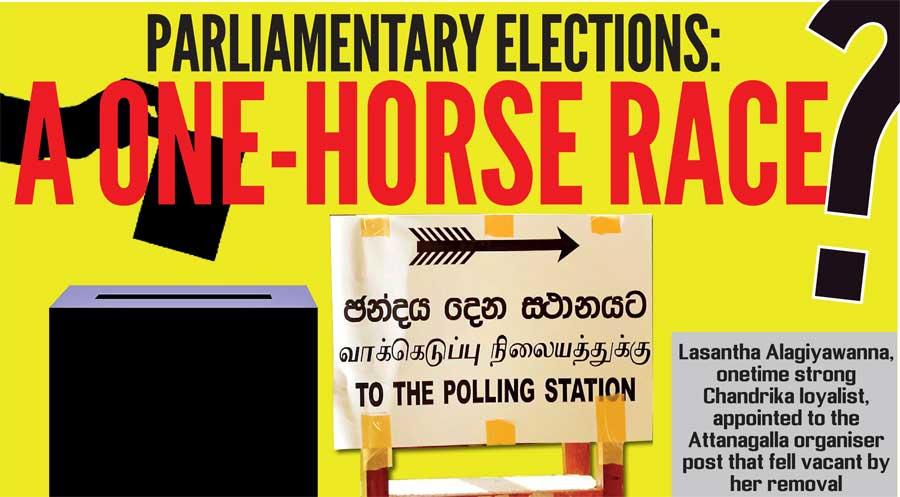Reply To:
Name - Reply Comment

One would wonder whether the United National Party (UNP) and Sri Lanka Freedom Party (SLFP) - two parties that alternately ruled the country for decades since independence - are vying for the title of ‘best loser’ at the oncoming parliamentary elections.
Interestingly, it was these two groups -- led by Ranil Wickremesinghe and Maithripala Sirisena respectively -- that joined hands at the presidential and parliamentary elections in 2015 to oust former President Mahinda Rajapaksa’s regime which was deemed then, by many, as invincible. 
One of the groups, bearing the SLFP tag, is now going behind Rajapaksa’s Sri Lanka Podujana Peramuna (SLPP) for parliamentary slots at the upcoming elections as it has been reduced to a spent force, while the other has been struggling for its very survival, in view of bitter infighting over its leadership which might cost them dearly at the same elections.
However, the two factions in the UNP, led by its leader Ranil Wickremesinghe and deputy leader Sajith Premadasa, have agreed upon a solution under which Wickremesinghe would retain UNP leadership while Premadasa, who had earlier been allowed to hold the opposition leader’s post, would spearhead the broader alliance that will be formed with several smaller parties.
Furthermore, the latter would be the prime ministerial candidate of the alliance -- an extra constitutional position -- at the upcoming general elections and the chairman of the nomination board to select candidates, according to the new settlement. He can choose the general secretary to the alliance, who should be from the UNP, but subject to approval of the UNP policy-making body: the Working Committee. UNP candidates selected by the nomination board should also be approved by the Working Committee in which Wickremesinghe musters majority power. That is the nature of powers Premadasa has been given.
These arrangements were decided upon by the Working Committee on January 30 sans Premadasa loyalists in it, since they had boycotted the meeting over the expulsion of several members of their faction from the committee. Yet, they too had consented with the arrangement later.
Given the possibility of the UNP-led coalition’s victory at the parliamentary elections being remote, it wouldn’t have been difficult for Wickremesinghe to be magnanimous to offer the leadership of the coalition and so-called prime ministerial candidacy to Premadasa. Both would have to be cast aside after the elections. It must also be recalled that despite having agreed to recognise Premadasa as the party’s presidential candidate, though after much wrangling, Wickremesinghe went on record subsequent to the presidential election saying he foresaw Premadasa’s defeat.
"SLFP has to dance to the tune of the SLPP as the general elections victory of the SLPP seems to be a foregone conclusion, even without the support of the SLFP"
On the other hand, if the SLFP had some bargaining power prior to the presidential election in its dealings with the SLPP in respect of power-sharing in their proposed coalition or seat-sharing at the parliamentary elections, it is no more. Now, the SLFP has to dance to the tune of the SLPP as the general elections victory of the SLPP seems to be a foregone conclusion, even without the support of the SLFP.
The SLFP Central Committee (CC) had taken two important but ironic decisions last month; one was to sack former President Chandrika Kumaratunga from the party’s Attanagalla organiser post and the other to support President Gotabaya Rajapaksa at the approaching parliamentary elections with a view to enable him to secure a two-thirds majority in Parliament and thereby to undo the 19th Amendment to the Constitution.
Interestingly, it was Kumaratunga who had proposed Maithripala Sirisena’s name as the common opposition candidate against President Mahinda Rajapaksa at the 2015 presidential race. The irony was that the same Sirisena has kicked her out from her ancestral electorate for not supporting Rajapaksas at the next round of the same race. This might be a precursor to her possible ouster from the very party that was formed by her father S.W.R.D. Bandaranaike in 1951 and led by her family for more than half a century until 2006.
Another important point is that it was Lasantha Alagiyawanna, onetime strong Chandrika loyalist who stood by her at all odds, who had been appointed to the Attanagalla organiser post that fell vacant by her removal.
It would have been difficult even to dream some five years ago that Maithripala Sirisena would support the Rajapaksas, especially to gain a two-thirds in Parliament and to abrogate the 19th Amendment. He fell out with the Rajapaksas in 2014 claiming that the latter was abusing power whereas he now wants to confer a two-thirds parliamentary power on them. Also, he who spearheaded the passage of the 19th Amendment in order to prevent any future President from abusing power, in the light of what he had then termed the dictatorship of the Rajapaksas, now wants the same piece of legislation to be scrapped to facilitate the Rajapaksas to have a smooth administration.
It is nothing but unprincipled personal agendas of Maithripala Sirisena and other SLFP leaders that lie beneath the decisions to oust Chandrika Kumaratunga from Attanagalla and to bestow President Gotabaya Rajapaksa with a two-thirds majority in Parliament. During his initial years in office, President Sirisena tried to send at least one or two Rajapaksas and several other Rajapaksa loyalists behind bars on corruption charges, with a view to prevent a comeback by the latter. It was foiled by apparent deals between the Rajapaksas and powerful UNP leaders who then were Sirisena’s partners in governance.
"It is nothing but unprincipled personal agendas of Maithri and other SLFP leaders that lie beneath the decisions to oust CBK from Attanagalla and to bestow Gota with a two-thirds majority in Parliament"
His hopes were totally dashed at the local government elections held on February 10, 2018 -- the first test of power since the Rajapaksas were routed three years ago -- as the SLPP had swept the electorate bagging more than 230 out of 340 local councils and 4.9 million votes. One-third of the UNP vote bank had eroded within three years and President Sirisena’s SLFP was pathetically pushed to the third rank with only 10 councils and 1.5 in hand.
President Sirisena then switched his strategies from ones adverse to the Rajapaksas to ones favorable to them. He improved the relationship with them which culminated in the ouster of Ranil Wickremesinghe from premiership and replacing him with Mahinda Rajapaksa on October 26 the same year. Wickremesinghe’s insolent attitude towards him too might have contributed to the situation. However, President Sirisena who once publicly said he would have been six-feet underground had he been defeated at the 2015 presidential election craftily opened an avenue for him to patch up with the Rajapaksas.
First, he was said to have wanted to contest the presidential election as the SLPP candidate, but leaders of that party ignored him. He then wanted to support SLPP candidate Gotabaya Rajapaksa on conditions such as Rajapaksa contesting under a common symbol instead of SLPP’s “lotus bud” and allocating a certain number of slots in the SLPP nomination list to his party at the next general elections. However, the SLPP went ahead disregarding the coalition talks with Maithri’s SLFP and succeeded in the presidential race thereby further reducing the latter’s bargaining power.
It is against this backdrop that the SLFP sacked Kumaratunga from her electorate and volunteered to confer a two-thirds to President Gotabaya Rajapaksa. They seem to be prepared to slacken their condition on the symbol at the general elections too. Everything is now decided by their compulsion to pacify and appease SLPP leaders without any principle being involved.